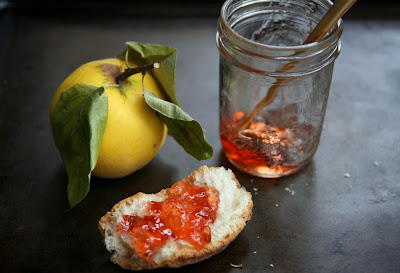Hello, We are here with New Recipes.You can tell us your questions and opinions about our recipes by leaving us a comment.We wish you a pleasant time.Bon Appetit.
A few years ago, I asked my Basque friend what to do with quinces. They grow all over Portland (including in the yard of my next-door neighbor, who generously gave me a bagful), but seem to have limited uses. You can stew them with long-cooked meat dishes, or make jelly, or the membrillo paste so beloved as part of an Iberian cheese plate. But I was hoping for some new ideas. "Well," my friend considered, as I leaned in close to get some exciting new inspiration. "Sometimes we put them in a car. You know, to make it smell nice."
So yeah, perhaps there aren't all that many things to do with quinces. But that's okay. Because the few things that you can do? Quite delicious. A raw quince is a rock-hard lump of pale, fuzzy, astringent nastiness. But once you cook them, they slump into rose-scented, rose-hued sweetness. The perfume alone can knock you out. What more do you need?
This jelly is more of a template than a recipe. You hack up quinces, skin and seeds and all (which, in addition to saving you some hassle, contributes a dose of pectin to help the whole batch set in a firm gel). Then you strain the mush, filter it into clarity, and cook it with sugar until it's sets into a gorgeous, fragrant jelly. You can use it to top your toast, or glaze a fruit tart, or add some rosy perfume to a cheese plate. You know, to make it smell nice.
And if you're looking for an aromatic condiment of a different sort, I direct you toward a recent radio story about fish sauce. In Ancient Rome. Sadly no rosy recipes, but on the upside: pirates! You can get a listen over at NPR.
Quince Jelly
adapted from several inspirations, including Food In Jars, Simply Recipes, and Chocolate and Zucchini
quinces
lemon
sugar
Wash your quinces, rubbing off the fuzz. Then hack them into rough cubes, skin and pits and all — trim away any nasty brown or wormy bits, but beyond that it's all fair game. Toss the cubes in a large pot with enough water to cover by barely an inch or so. Bring to a boil, then reduce heat until it's just high enough to maintain a vigorous simmer. Cook until the quince bits are totally mushy-soft, and beginning to take on a rosy hue, about an hour (you can also do this in a pressure cooker).
Pour the mixture through a strainer to capture the quince cooking liquid (you can run the quince pieces themselves through a food mill, or simply compost them — they'll have given up most of their flavor to the liquid). Measure the resulting liquid, and for every quart, add the juice of a small lemon.
Pass the liquid through a single layer of cheesecloth or loose-weave dishcloth, then through a couple layers of cheesecloth (or a coffee filter), to end up with a clear pink liquid. This final straining can take a while. If you are lazy or late-starting like me, you can leave it to drip overnight, and make your jelly the next day.
When you're ready to make the jelly, pour the quince liquid into a wide-bottom pot, and add a generous 3/4 cup sugar for every cup of juice. Bring to a boil, then reduce the heat slightly to a vigorous-but-not-crazy boil. You'll need to cook the mixture down to the gel point, which should take at least a half hour and up to an hour, over which time it will thicken and darken to a ruby color, and the quince flavor will concentrate. When you think it's becoming syrupy, place a few small plates in the freezer to chill. If you want to process the jelly, prepare your jars and start a boiling water bath.
To test the jelly, drip a few drops onto a freezer-chilled plate. Let sit a minute, then push into the edge of the drop with your finger. You don't need to see a full jelly-like set, but it should just begin to wrinkle and mound ahead of your finger as you push it. When it reaches this stage, you're done! Pour into your prepared jars, seal, and process in a boiling water bath if desired. The jelly may take some time to set, but will end up fairly firm.
Subscribe to:
Post Comments (Atom)


